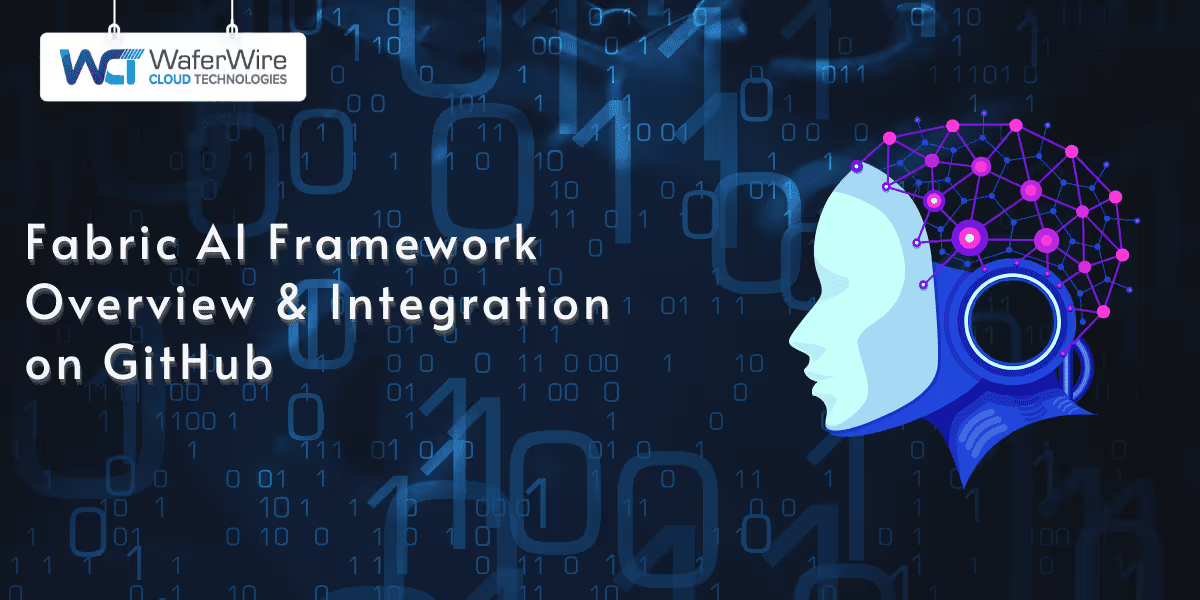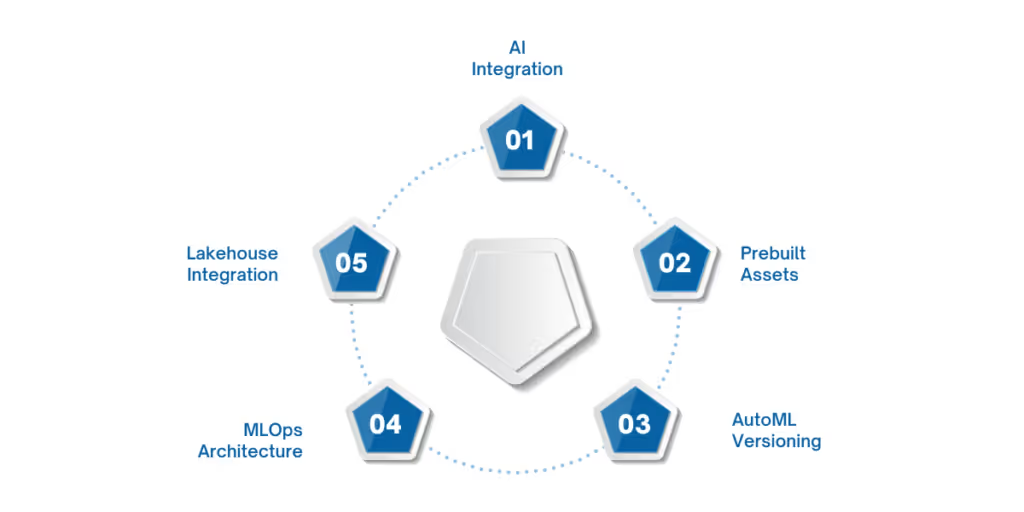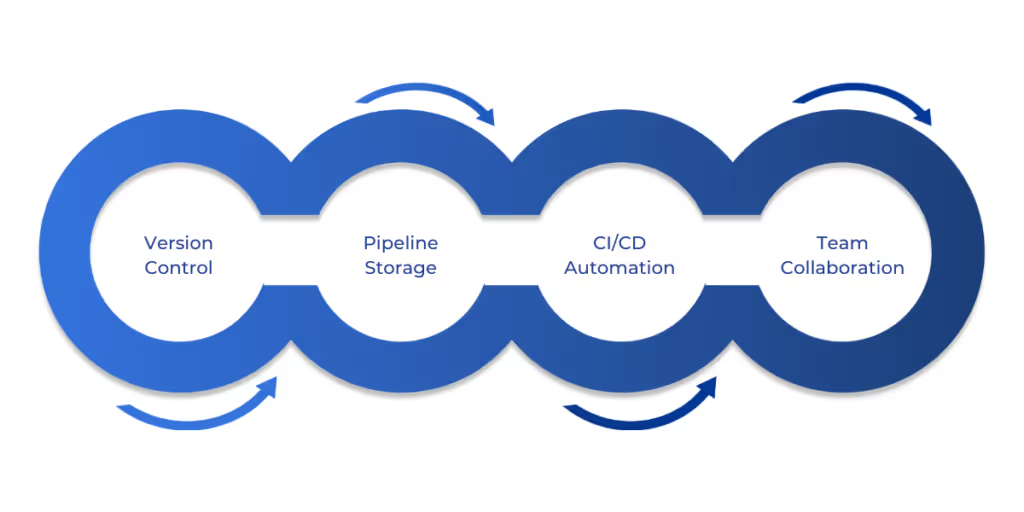

As the business world is getting increasingly driven by data significantly, the ability to unify data engineering, analytics, and Artificial Intelligence (AI) under one platform is a game-changer for organizations seeking to accelerate decision-making.
Microsoft Fabric is designed to do exactly that. As an end-to-end, SaaS-based analytics platform, Microsoft Fabric consolidates powerful capabilities, such as data movement, data science, real-time analytics, and Business Intelligence (BI), into a single unified experience.
At the heart of Fabric’s intelligence capabilities lies the Fabric AI Framework, a flexible and scalable toolkit that enables data professionals to embed Machine Learning (ML) and AI into their workflows. However, powerful frameworks need robust development workflows. That’s where GitHub integration becomes essential.
By connecting Fabric to GitHub, teams can manage code versions, collaborate across repositories, and automate deployments using Continuous Integration (CI)/Continuous Delivery (CD) pipelines. Let’s find out more about this fusion in this article.
To understand the value of this fusion, let’s first break down what the Fabric AI Framework offers.
The Fabric AI Framework is Microsoft Fabric’s integrated solution for embedding AI and ML directly into your data workflows. It offers a comprehensive set of tools and capabilities that enable organizations to build, train, deploy, and manage AI models across the entire data lifecycle, all within the unified Fabric environment.
The Fabric AI Framework bridges the gap between data engineering and intelligent analytics. It enables users to seamlessly integrate AI into their data pipelines, automate model training and scoring, and generate actionable insights, all while leveraging the scalability and governance features built into the Microsoft ecosystem.
To fully appreciate how Fabric AI works, let’s explore its key features and capabilities.

The Fabric AI Framework is built to empower teams with powerful, production-grade AI tools that are deeply integrated with Microsoft’s modern data stack. Its features support everything from experimentation to deployment at scale, making it an ideal foundation for enterprise AI initiatives.
Fabric allows you to embed machine learning models directly into your data pipelines. Whether for batch or real-time scoring, models can be trained, evaluated, and deployed as part of the same workflow, minimizing context switching and speeding up iteration cycles.
To accelerate development, the framework offers a growing library of prebuilt components and reusable templates:
These resources help teams get started quickly without having to write boilerplate code from scratch.
Fabric includes AutoML capabilities, enabling users to automatically explore multiple algorithms, tune hyperparameters, and select the best-performing models. Once models are trained, they are versioned and stored within the Fabric workspace, making it easy to track performance over time, roll back changes, and promote models between environments.
The framework supports MLOps best practices by integrating with the following:
This architecture ensures that models transition smoothly from experimentation to production, maintaining traceability and compliance.
Fabric’s native Lakehouse architecture and OneLake storage system unify structured, unstructured, and streaming data. This provides AI models with immediate access to enterprise-wide data, eliminating duplication.
The result: simplified data access, faster training, and consistent data governance across analytics and AI workloads.
To understand how these features come together in practice, it’s essential to examine GitHub’s role in the overall architecture.
Also Read: Managing Microsoft Fabric Capacity and Licensing Plans

GitHub plays a critical role in enabling collaborative development and robust DevOps practices within the Fabric AI Framework:
So, how do you connect these systems in practice? Let’s walk through the integration process.
Integrating Microsoft Fabric with GitHub enables a seamless development lifecycle, facilitating version control, team collaboration, and automated deployment for AI and analytics projects.
Below is a step-by-step guide to setting up and managing GitHub integration effectively.
You can automate testing, training, and deployment with either GitHub Actions or Azure DevOps:
GitHub Actions: Sample Workflow
name: Fabric AI CI/CD
on:
push:
branches: [ main ]
jobs:
deploy:
runs-on: ubuntu-latest
steps:
- name: Checkout Code
uses: actions/checkout@v3
- name: Deploy Pipeline to Fabric
run: |
az login --service-principal -u ${{ secrets.CLIENT_ID }} -p ${{ secrets.CLIENT_SECRET }} --tenant ${{ secrets.TENANT_ID }}
az fabric pipeline deploy --name "CustomerChurnPipeline" --file pipelines/churn_pipeline.yml
Azure DevOps:
Use a pipeline YAML file with steps to:
Connect Azure DevOps to Fabric via service principal and API integration.
Once the integration is active:
You can also tag stable versions using Git tags (eg., v1.0.0, v2.1.1), which helps with rollbacks and release management.
Once integration is in place, you’ll want to understand how to structure and manage your AI projects for maximum efficiency. That’s where best practices come into play.
Also Read: Get Started with Data Science in Microsoft Fabric
To ensure scalability, maintainability, and security in your AI projects built on Microsoft Fabric and GitHub, it’s essential to follow structured development and DevOps principles. Below are recommended best practices across architecture, security, and operational management.
Organizing your repository with a standardized structure enhances collaboration and facilitates team onboarding more efficiently. Here’s a suggested layout: Prefix files with numbers or labels (01_eda.ipynb, 02_train_model.ipynb) to suggest execution order.
Avoid hardcoding credentials, API keys, or workspace identifiers in your code or YAML files.
Build your pipelines and models in a modular fashion to encourage reuse and reduce duplication:
Operationalizing AI responsibly means tracking performance, lineage, and access. Fabric and Azure provide built-in tools to help.
Even with best practices, though, technical issues can still arise. Let’s look at how to troubleshoot the most common ones.
While Microsoft Fabric and GitHub integration streamlines AI development, certain technical hiccups can slow you down. Here’s a breakdown of frequent issues and how to resolve them quickly.
Issue: Notebooks or pipeline files not syncing between Fabric and GitHub.
Resolution:
Issue: Authentication fails when connecting Fabric to GitHub or deploying via GitHub Actions.
Resolution:
Issue: 403 or 404 errors when pushing or pulling from GitHub.
Resolution:
Issue: GitHub Action runs but fails during deployment step.
Resolution:
Issue: Environment variables not working in GitHub Actions.
Resolution:
Also Read: Fabric Data Integration Best Practices Guide
Microsoft Fabric is rapidly transforming the way organizations build, scale, and operationalize AI projects, bringing together data engineering, ML, and analytics into a unified platform. When combined with GitHub’s powerful version control, collaboration, and CI/CD capabilities, Fabric becomes a true end-to-end environment for AI innovation.
From orchestrating data pipelines and training models to visualizing insights and deploying workflows, the Fabric AI Framework empowers data teams to work faster and smarter, while ensuring code quality, reproducibility, and governance through seamless GitHub integration.
Ready to streamline your AI workflows and unlock the true power of GitHub-integrated Fabric pipelines?
At WaferWire, we specialize in helping businesses like yours implement, optimize, and scale AI solutions using Microsoft Fabric and GitHub CI/CD best practices. From setting up secure development environments to automating deployment pipelines, our experts ensure your data and AI initiatives are robust, compliant, and future-ready.
Contact WaferWire today for a personalized consultation and discover how we can accelerate your journey to operational AI with Microsoft Fabric and GitHub integration.

